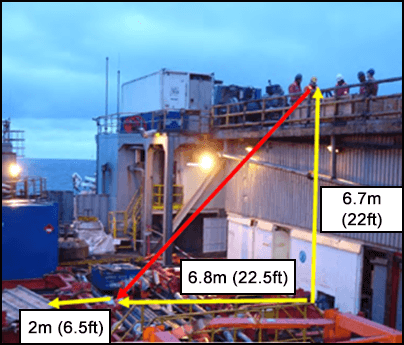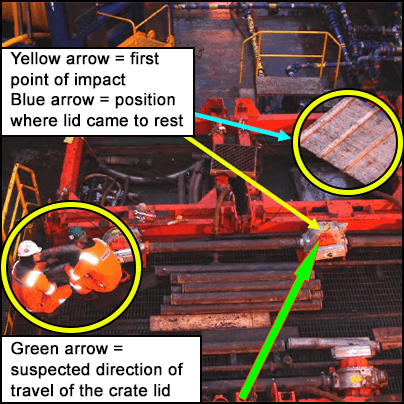-
What happened?
A wooden crate was on a raised catwalk on an oil rig.
The wind dislodged the lid of the wooden crate.
The lid, weighing 37kg (81lb), was blown down to the well-test deck 6.7m (22ft) below.
It landed 2.5m (8ft) from where two engineers were working, then slid along a further 2m (6ft).

-
Why did it happen?
The lid was not secured correctly – the nails did not penetrate the crate’s side panels.
The risks of dropped objects for workers in open areas during high winds had not been assessed.
Several of the crates were deemed not fit for purpose but had not been secured.
The control of personnel in sheltered areas working during high winds had not been assessed for potential dropped objects and flying debris hazards.
In general, there was poor understanding of the necessary lifting practices for lifting wooden crates slung directly underneath cranes.

-
What did they learn?
Check the security of all wooden crates and their lids prior to any periods of high winds – ensure nails are not used as the sole securing device.
Before authorising work outside during periods of adverse weather, assess the likelihood of potential flying debris/dropped objects, including of ‘sheltered areas’.
Review the long-term storage of spare parts in wooden crates that are exposed to the elements. Ensure crates are adequately secured or moved to internal storage areas.
Ensure there is a lift plan in place for the lifting of all wooden crates directly by the crane, and ensure recommended rigging practices for this type of lift are employed. (However, avoid this type of lift if at all possible)
Avoid back loading equipment / spare parts in pre-used wooden crates. Crates should preferably be single use only.

-
Ask yourself or your crew
How can something like this happen here?
How are crate lids secured on our worksite? What can we do better?
When windy, what debris or equipment can become loose on our worksite?
What other dropped object hazards have we identified? How can we mitigate these risks?
Have we assessed the risk from dropped objected for personnel working in sheltered areas?

Add to homescreen
Content name
Select existing category:
Content name
New collection
Edit collection
What happened?
A wooden crate was on a raised catwalk on an oil rig.
The wind dislodged the lid of the wooden crate.
The lid, weighing 37kg (81lb), was blown down to the well-test deck 6.7m (22ft) below.
It landed 2.5m (8ft) from where two engineers were working, then slid along a further 2m (6ft).

Why did it happen?
The lid was not secured correctly – the nails did not penetrate the crate’s side panels.
The risks of dropped objects for workers in open areas during high winds had not been assessed.
Several of the crates were deemed not fit for purpose but had not been secured.
The control of personnel in sheltered areas working during high winds had not been assessed for potential dropped objects and flying debris hazards.
In general, there was poor understanding of the necessary lifting practices for lifting wooden crates slung directly underneath cranes.

What did they learn?
Check the security of all wooden crates and their lids prior to any periods of high winds – ensure nails are not used as the sole securing device.
Before authorising work outside during periods of adverse weather, assess the likelihood of potential flying debris/dropped objects, including of ‘sheltered areas’.
Review the long-term storage of spare parts in wooden crates that are exposed to the elements. Ensure crates are adequately secured or moved to internal storage areas.
Ensure there is a lift plan in place for the lifting of all wooden crates directly by the crane, and ensure recommended rigging practices for this type of lift are employed. (However, avoid this type of lift if at all possible)
Avoid back loading equipment / spare parts in pre-used wooden crates. Crates should preferably be single use only.
Ask yourself or your crew
How can something like this happen here?
How are crate lids secured on our worksite? What can we do better?
When windy, what debris or equipment can become loose on our worksite?
What other dropped object hazards have we identified? How can we mitigate these risks?
Have we assessed the risk from dropped objected for personnel working in sheltered areas?
A wooden crate was on a raised catwalk on an oil rig. The wind dislodged the lid of the wooden crate and it fell to the deck below.













